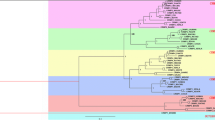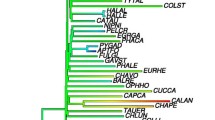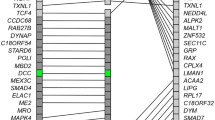Abstract
Neurotrophin proteins are essential for the survival, differentiation, and maintenance of neurons in the peripheral and central nervous systems. Recent studies have shown that the unprocessed proforms of the neurotrophins are preferential high-affinity ligands for p75NTR and potent inducers of p75NTR-mediated cell death. Here, we explore differences in the selective constraints acting on the proregions of the three avian neurotrophin genes—NT-3, BDNF, and NGF—in an explicit phylogenetic context. We found a 50-fold difference in levels of constraint as estimated by d N/d S ratios, with the NGF proregion showing the lowest degree of constraint and BDNF the highest. These patterns suggest that the high conservation exhibited by the BDNF proregion results from intense functional constraints that are relaxed in NGF and somewhat relaxed in NT-3. The proregion of BDNF is likely to have a function that differentiates it from the corresponding regions of the NGF and NT-3 genes, suggesting that BDNF is the avian neurotrophin most likely to be used both in its precursor and mature forms in vivo.



Similar content being viewed by others
References
MS Beattie AW Harrington R Lee JY Kim SL Boyce FM Longo JC Bresnahan BL Hempstead SO Yoon (2002) ArticleTitleProNGF induces p75-mediated death of oligodendrocytes following spinal cord injury. Neuron 36 375–386 Occurrence Handle12408842
G-J Caspers U Uit de Weerd J Wattel WW de Jong (1997) ArticleTitleAlpha-crystallin sequences support a Galliform/Anseriform clade. Mol Phylogenet Evol 2 185–188 Occurrence Handle10.1006/mpev.1996.0384
MV Chao (2000) ArticleTitleTrophic factors: An evolutionary cul-de-sac or door into higher neuronal function? J Neurosci 59 353–355 Occurrence Handle10.1002/(SICI)1097-4547(20000201)59:3<353::AID-JNR8>3.3.CO;2-J
MV Chao M Bothwell (2002) ArticleTitleNeurotrophins, to cleave or not to cleave. Neuron 33 9–12 Occurrence Handle11779474
RT Dobrowsky BD Carter (2000) ArticleTitlep75 Neurotrophin receptor signaling: Mechanisms for neurotrophic modulation of cell stress? J Neurosci 61 237–243 Occurrence Handle10.1002/1097-4547(20000801)61:3<237::AID-JNR1>3.0.CO;2-M
T Ebendal D Larhammar H Persson (1986) ArticleTitleStructure and expression of the chicken beta nerve growth factor gene. EMBO J 5 1483–1487 Occurrence Handle3017695
WJ Friedman A Greene (1999) ArticleTitleNeurotrophin signaling via Trks and p75. Exp Cell Res 25 131–142 Occurrence Handle10.1006/excr.1999.4705
N Goldman JP Anderson AG Rodrigo (2000) ArticleTitleLikelihood-based tests of topologies in phylogenetics. Syst Biol 49 652–670 Occurrence Handle1:STN:280:DC%2BD38zntVOjtw%3D%3D Occurrence Handle12116432
JG Groth GF Barrowclough (1999) ArticleTitleBasal divergences in birds and the phylogenetic utility of the nuclear RAG-1 gene. Mol Phylogenet Evol 12 115–123 Occurrence Handle10.1006/mpev.1998.0603 Occurrence Handle1:CAS:528:DyaK1MXjvFWrsLY%3D Occurrence Handle10381315
F Hallböök (1999) ArticleTitleEvolution of the vertebrate neurotrophin and Trk receptor gene families. Curr Opin Neurobiol 9 616–621 Occurrence Handle10508739
F Hallböök L-G Lundin K Kullander (1998) ArticleTitle Lamtera fluviatilis neurotrophin homolog, descendent of a neurotrophin ancestor, discloses the early molecular evolution of neurotrophins in the vertebrate subphylum. J Neurosci 18 8700–8711 Occurrence Handle9786977
G Heinrich T Lum (2000) ArticleTitleFish neurotrophins and Trk receptors. Int J Dev Neurosci 18 1–27 Occurrence Handle10.1016/S0736-5748(99)00071-4 Occurrence Handle10708902
JP Huelsenbeck (2000) MrBayes: Bayesian inference of phylogeny. Distributed by the author. Department of Biology, University of Rochester Rochester, NY
CF Ibáñez (2002) ArticleTitleJekyll-Hyde neurotrophins: The story of proNGF. Trends Neurosci 25 284–286 Occurrence Handle10.1016/S0166-2236(02)02169-0 Occurrence Handle12086739
CF Ibáñez T Ebandal G Barbany J Murray-Rust TL Blundell H Persson (1992) ArticleTitleDisruption of the low affinity receptor-binding site in NGF allows neuronal survival and differentiation by binding to the trk gene product. Cell 69 329–341 Occurrence Handle1314703
CF Ibáñez L Ilag J Murray-Rust H Persson (1993) ArticleTitleAn extended surface of binding to Trk tyrosine kinase receptors in NGF and BDNF allows the engineering of a multifunctional pan-neurotrophin. EMBO J 12 2281–2293 Occurrence Handle8508763
Y Ina (1995) ArticleTitleNew methods for estimating the numbers of synonymous and nonsynonymous substitutions. J Mol Evol 40 190–226 Occurrence Handle1:CAS:528:DyaK2MXjsVyksbg%3D Occurrence Handle7699723
KR Jones LF Reichardt (1990) ArticleTitleMolecular cloning of a human gene that is a member of the nerve growth factor family. Proc Natl Acad Sci USA 87 8060–8064 Occurrence Handle2236018
DR Kaplan D Miller (2000) ArticleTitleNeurotrophin signal transduction in the nervous system. Curr Opin Neurobiol 10 381–391 Occurrence Handle10.1016/S0959-4388(00)00092-1 Occurrence Handle10851172
S Kumar K Tamura IB Jakobsen M Nei (2001) ArticleTitleMEGA2: Molecular Evolutionary Genetics Analysis software. Bioinformatics 17 1244–1245 Occurrence Handle1:CAS:528:DC%2BD38XmtVCktQ%3D%3D Occurrence Handle11751241
R Lee P Kermani KK Teng BL Hempstead (2001) ArticleTitleRegulation of cell survival by secreted proneurotrophins. Science 294 1945–1948 Occurrence Handle10.1126/science.1065057 Occurrence Handle11729324
WP Maddison DR Maddison (1992) MacClade: Analysis of phylogeny and character evolution, version 3.06. Sinauer Associates Sunderland, MA
DP Mindell MD Sorenson DE Dimcheff M Hasegawa JC Ast T Yuri (1999) ArticleTitleInterordinal relationships of birds and other reptiles based on whole mitochondrial sequences. Syst Biol 48 138–152 Occurrence Handle1:STN:280:DC%2BD38zjslSjtA%3D%3D Occurrence Handle12078637
SJ Mowla HF Farhadi S Pareek JK Atwal SJ Morris NG Seidah RA Murphy (2001) ArticleTitleBiosynthesis and post-translational processing of the precursor to brain-derived neurotrophic factor. J Biol Chem 276 12660–12666 Occurrence Handle10.1074/jbc.M008104200 Occurrence Handle11152678
M Nei T Gojobori (1986) ArticleTitleSimple methods for estimating the numbers of synonymous and nonsynonymous nucleotide substitutions. Mol Biol Evol 3 418–426 Occurrence Handle1:CAS:528:DyaL28Xmt1aisbs%3D Occurrence Handle3444411
A Patapoutian LF Reichardt (2001) ArticleTitleTrk receptors: Mediators of neurotrophin action. Curr Opin Neurobiol 11 272–280 Occurrence Handle10.1016/S0959-4388(00)00208-7 Occurrence Handle11399424
A Rattenholl M Ruoppolo A Flagiello M Monti F Vinci G Marino H Lilie E Schwarz R Rudolph (2001a) ArticleTitlePro-sequence assisted folding and disulfide biformation of human nerve growth factor. J Mol Biol 305 523–533
A Rattenholl H Lilie A Grossmann A Stern E Schwarz R Rudolph (2001b) ArticleTitleThe pro-sequence facilitates folding of human nerve growth factor from Escherichia coli inclusion bodies. Eur J Biochem 268 3296–3303
CG Sibley JE Ahlquist (1990) Phylogeny and classification of birds. Yale University Press New Haven, CT
U Suter JV Heymach Jr EM Shooter (1991) ArticleTitleTwo conserved domains in the NGF propeptide are necessary and sufficient for the biosynthesis of correctly processed and biologically active NGF. EMBO J 10 2395–2400 Occurrence Handle1868828
DL Swofford (1999) PAUP*: Phylogenetic analysis using parsimony (*and other methods), version 4.0b2. Sinauer Sunderland, MA
R Urfer P Twoulfas D Soppet E Escandon LF Parada LG Presta (1994) ArticleTitleThe binding epitopes of neurotrophin-3 to its receptors trkC and gp75 and the design of a multifunctional human neurotrophin. EMBO J 13 5806–5909
M Van Tuinen CG Sibley SB Hedges (2000) ArticleTitleThe early history of modern birds inferred from DNA sequences of nuclear and mitochondrial ribosomal genes. Mol Biol Evol 17 451–457 Occurrence Handle1:CAS:528:DC%2BD3cXhvVahsLo%3D Occurrence Handle10723745
A Wetmore (1960) ArticleTitleA classification for the birds of the world. Smithson Misc Collect 139 IssueID11
Z Yang (1997) ArticleTitlePAML: A program for phylogenetic analysis by maximum likelihood. Comput Appl Biosci 13 555–556 Occurrence Handle9367129
Acknowledgements
We thank Tom Smith for samples and support at the Center for Tropical Research, Robert Ricklefs and Lisa Tell for additional samples, and Sonya Clegg, Finn Hallböök, and Enrique Lessa, for comments on an early version of the manuscript. We thank Carlos Ibañez for insightful suggestions and Rasmus Nielsen for advice on data analysis. R.N.M.S. was supported by a Research Infrastructure in Minority Institutions award from the National Center for Research Resources with funding from the Office of Research on Minority Health, National Institutes of Health Grant 5 P20 RR11805. R.N.M.S. was also supported by an NIGMS MORE Institutional Research and Academic Career Development Award to UC Davis and San Francisco State University, (http://prof.ucdavis.edu/ ; Grant K12GM00679). This work was also funded by Grants NSF-DEB9726425 and NSF-IRCEB9977072.
Author information
Authors and Affiliations
Corresponding author
Rights and permissions
About this article
Cite this article
Sehgal, R.N., Lovette, I.J. Molecular Evolution of Three Avian Neurotrophin Genes: Implications for Proregion Functional Constraints . J Mol Evol 57, 335–342 (2003). https://doi.org/10.1007/s00239-003-2484-8
Received:
Accepted:
Issue Date:
DOI: https://doi.org/10.1007/s00239-003-2484-8




